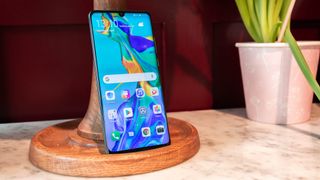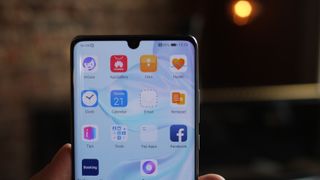IT Pro Verdict
Steep price aside, the P30 Pro is a beautiful smartphone, with exceptional battery life and a set of unparalleled cameras - Huawei is zooming to the top.
Pros
- +
Super camera technology; Gorgeous design; Large Battery
Cons
- -
Expensive
There's no denying that Huawei produces high-quality smartphones; 2018's Huawei 20 Pro proved popular with critics and consumers alike, and the firm's more recent Mate 20 Pro received glowing reviews, including one from IT Pro.
The firm's next instalment in the P-series has now arrived, and it has its sights set on similar success. Building on the strengths of its predecessor, the Huawei Mate 30 Pro is a handset that looks set to shake up Apple and Samsung's long-held duopoly with its high-end design, quad-camera setup and market-leading performance credentials.
But how did the Huawei P30 Pro hold up under our rigorous tests?
It's a colourful, camera-heavy beauty, but how did the P30 Pro hold up under our rigorous tests?
Huawei P30 Pro review: Design
From the front, it's getting increasingly difficult to tell the difference between the latest flagship models. All are edge-to-edge displays without home buttons (RIP) and it seems like a display's only distinguishing feature these days is the front camera, and in particular, how it's housed. For the Galaxy S10, Samsung developed a special process to cut out a hole in the screen; Apple, on the other hand, is still rocking the notch on the iPhone Xs. For the P30, Huawei has opted for a tasteful teardrop at the top.

It's much easier to put a definitive stamp on the back cover of the phone and this is where the P30 Pro really stands out from the rest. The Chinese firm has taken the design from the P20 and enhanced it with glorious colours and smoother curves. The result is a sleek handset that sparkles. The P30 and the Pro come in five eye-catching colours, the majority of which have a delightful two-tone finish: 'Aurora', a sumptuous blue, 'Breathing Crystal', a striking light blue, 'Amber Sunrise', which is basically orange, and your old favourites, black and white. Silly names aside, few manufacturers have offered as much choice with colours since the days of the iPhone 5c.
The P30 Pro is seamlessly constructed with a curved glass front and back. It's very smooth, very shiny and, after about 2 minutes in the hand, very smudgy. There are four cameras on the back, three of which are fitted into a vertical black bar - similar to the horizontal one used on the S10 - with a fourth lens placed alongside. The Huawei and Leica logos run vertically, below the cameras, finishing off quite a neat design. Fitting five cameras in and making the device pretty is not easy - Nokia's PureView used the same amount and came out looking more bug-eyed than beautiful.
Huawei P30 Pro review: Display
The P30 Pro's front camera has been placed dead centre, at the top of the screen, in a teardrop-shaped notch which hardly takes up any space in the 6.47in screen - which is a tiny bit bigger than the S10+. This OLED FHD+ display has a 19.5:9 aspect ratio and a resolution of 2,340 x 1,080, both of which sounds good on paper.

And, it was good in our in-house tests too. In the phone's "Normal" display profile, the P30 Pro's screen proved to be reasonably colour accurate and able to reproduce 95.7% of the sRGB colour gamut with a total volume of 109% - for comparison, the S10+ hit 94.7%, which is a tiny margin, but a clear indicator of the quality as Samsung is widely regarded to be one of the best around for producing fantastic displays. What's more, the P30 Pro's screen is capable of reaching an absolutely staggering peak luminance of 854cd/m in the phone's auto-brightness mode and, with this being an OLED panel, colour contrast is effectively perfect.
Without a home button, the P30 has taken its biometric security and housed it in the screen, like the S10 and the OnePlus 6T. There's also more space saved by not housing a speaker at the top; instead, Huawei has added a magnetic suspension system, which uses vibrations beneath the screen to create the sound. This, the company says, will stop other people from being able to listen in to your private calls - but we could still hear the other end of the line with the phone at arm's length.
Huawei P30 Pro review: Specs and Performance
Like the recently launched Mate 20 Pro, the P30 Pro is housing Huawei's own brand of processor, the Kirin 980 chipset, which is built using a 7nm fabrication process. This 2.6GHz octa-core processor is more power efficient than older chips built on 10nm or larger. In theory, the smaller fabrication process means more power for the same size chip and better battery life, which was certainly evident with the Mate 20 Pro. There's also 8GB of RAM to go with it, which is now quite standard for flagship - see S10+, OnePlus 6T, Mate 20 Pro, and pretty much every other smartphone released in the last year.
In our tests, the P30 Pro's performance benchmark results were fast. In the Geekbench 4 single and multi-core tests, the P30 Pro produced near-identical scores to the regular P30 and last year's P20 Pro. At 3,302 for single and 9,720 multiple though, it did fall short of the S10+, but from personal use, it feels like one the fastest smartphones we've ever had - very snappy, responsive and capable of keeping it up with multiple apps open.

It can keep going for quite a while too, with a significantly improved battery life. Our in-house video rundown test shows that the Huawei's P30 Pro's stamina is roughly 39% longer than its predecessor, the P20 Pro, reaching an impressive total of 21hrs 22mins before its 4,300mAh capacity battery was done. That's 5 minutes longer than the S10+ managed. Once more Huawei is supporting 40W 'Super Charge' technology, and it says that for around 30 minutes plugged in, the device can regain 70% charge, which we can confirm is accurate.
The device can use both facial recognition and fingerprint sensor technology to unlock, and both work seamlessly with the facial recognition taking less than a second. There's a USB-C port for both charging and audio - the 3.5mm headphone jack is as dead to smartphones as physical keypads (sorry BlackBerry). There's also a lack of MicroSD expansion, which is a little more annoying if you need more than the 128GB on offer as standard and don't want to pay an extra 200 for 512GB.
Huawei P30 Pro review: Camera(s)
Although the P30 Pro has a gorgeous design, snappy processor and long battery life, the real standout feature of this device is the quadruple Leica camera array. In total, it has five cameras (there's a 32-megapixel camera on the front). Starting with the quartet of rear snappers, the main camera is a 40-megapixel 'super spectrum' camera, which, according to the company, is a radical change to the way the sensor takes in light.
Most camera systems are built on sensors that handle red, green and blue pixels - every pixel is made up of a single red, a single blue and two green pixel sensors. Huawei has built a sensor that swaps the green for yellow and using yellow light can add additional red light information into the amount that is being absorbed. It already absorbs red, but with the yellow colour, it can absorb extra red light as well as green to create images richer in detail. This is evident in the 'night mode' the camera uses, which practically takes pictures in the black of night and makes them like clear day photos.

Another of the ground-breaking cameras on the P30 Pro is a telephoto lens with 5x optical zoom. Ironically, for a company regularly accused of espionage, it has developed a camera capable of capturing vivid detail from extreme distances. Already we've seen people post videos and photos on Twitter of the dangerous abilities of this camera. People in tower blocks have used it to see into a sports stadium and another man was able to see two men playing checkers from an exceptional distance.
There is also a 20-megapixel ultra-wide-angle lens and a 'Time-of-Flight" camera, which adds depth information to photographs by measuring the speed at which light is reflected back to the sensor - a feature which Huawei described as similar to the way a bat uses sonar. This indulgence of cameras is now quite common - see the Nokia PureView, for example - but Huawei is offering capabilities that the other manufacturers don't seem to be thinking about. For instance, there's also a dual-camera mode where the screen can show the images from two of its multiple lenses simultaneously, such as the wide lens and the optical zoom, allowing you to pick between them.
Huawei P30 Pro review: Verdict
When the P20 Pro was launched, Huawei managed to bring to market a device that competed with the iPhone X and the Galaxy S9 for build quality and performance, but at a significantly cheaper price. The same is true of the P30 Pro, which is another quality handset capable of sitting with the elite, though Huawei is now charging higher prices more closely aligned with Apple and Samsung's latest and greatest; the P30 Pro is £899 - the same as the Galaxy S10+ and not too far off the iPhone Xs.
It's evidence to suggest that Huawei is no longer an underdog or the smartphone maker in the ascendency - it's now in the big leagues. If you want a quality smartphone for a cheaper price, that seems to now be reserved for the likes of Oppo, OnePlus and Xiaomi. But Huawei is pushing technical limits and revolutionising smartphones standards - as Apple and Samsung used to before it. Although it's a steep price, you're getting a beautiful looking smartphone, with exceptional battery life, smart features and set of unparalleled cameras. Huawei really is zooming to the top.
Verdict
Steep price aside, the P30 Pro is a beautiful smartphone, with exceptional battery life and a set of unparalleled cameras - Huawei is zooming to the top.
| Processor | Octa-core Kirin 980 |
| RAM | 8GB (128/512GB) |
| Screen size | 6.47in |
| Screen resolution | 1,080 x 2,340 |
| Pixel density | 398ppi |
| Screen type | OLED |
| Front camera | 32MP, f/2.0 |
| Rear camera | Quad: 40MP f/1.6, (wide), 20MP f/2.2 (ultrawide), 8MP (telephoto), TOF 3D camera |
| USB connection type | USB Type-C |
| Storage options | 128GB; 512GB |
| Dimensions | 73.4 x 8.4 x 158mm |
| Weight | 192g |
| Operating system | Android 9 Pie |
| Battery size | 4,100mAh |
Bobby Hellard is ITPro's Reviews Editor and has worked on CloudPro and ChannelPro since 2018. In his time at ITPro, Bobby has covered stories for all the major technology companies, such as Apple, Microsoft, Amazon and Facebook, and regularly attends industry-leading events such as AWS Re:Invent and Google Cloud Next.
Bobby mainly covers hardware reviews, but you will also recognize him as the face of many of our video reviews of laptops and smartphones.

